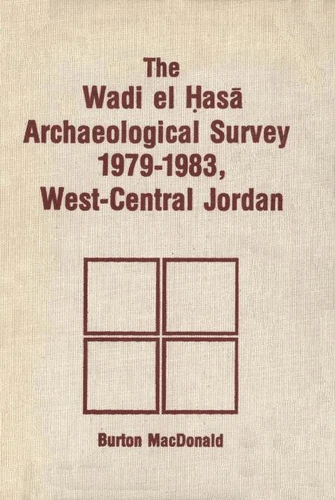Wadi el Hasa Archaeological Survey 1979-1931, West-Central Jordan
Par :Formats :
Disponible dans votre compte client Decitre ou Furet du Nord dès validation de votre commande. Le format PDF est :
- Compatible avec une lecture sur My Vivlio (smartphone, tablette, ordinateur)
- Compatible avec une lecture sur liseuses Vivlio
- Pour les liseuses autres que Vivlio, vous devez utiliser le logiciel Adobe Digital Edition. Non compatible avec la lecture sur les liseuses Kindle, Remarkable et Sony
 , qui est-ce ?
, qui est-ce ?Notre partenaire de plateforme de lecture numérique où vous retrouverez l'ensemble de vos ebooks gratuitement
Pour en savoir plus sur nos ebooks, consultez notre aide en ligne ici
- Nombre de pages422
- FormatPDF
- ISBN978-0-88920-719-6
- EAN9780889207196
- Date de parution15/03/2012
- Protection num.Digital Watermarking
- Taille20 Mo
- Infos supplémentairespdf
- ÉditeurWilfrid Laurier University Press
Résumé
In this major work Professor MacDonald chronicles an intensive and systematic archaeological survey of the southern flank of the Wadi el Hasa in West-Central Jordan. The survey resulted in the recovery of human evidence spanning the Lower Paleolithic to the Ottoman period (500, 000 B. C.-A. D. 1918). The area is cut by a number of impressive and deep, south-to-north flowing wadis. As a region marginal for farming but stable for grazing, it would be the first to "empty out" and the last to "fill up" compared to more favourable regions.
The methodology employed included a combination of purposive, predictive, and pedestrian transects. Lithics spanning the Lower Paleolithic to the end of the Early Bronze period (500, 000-2000 B. C.) and ceramics covering the period from the Pottery Neolithic to the end of the Ottoman domination (4750 B. C.-A. D. 1918) were collected in the area. Sites surveyed included lithic and sherd scatters, camps, hamlets, villages, roads, milestones, fortresses, watchtowers, and mills.
This research sheds new light on the settlement of the area, which now appears to have been most dense during the Middle Paleolithic, Iron II, Nabataean, and Byzantine periods.
The methodology employed included a combination of purposive, predictive, and pedestrian transects. Lithics spanning the Lower Paleolithic to the end of the Early Bronze period (500, 000-2000 B. C.) and ceramics covering the period from the Pottery Neolithic to the end of the Ottoman domination (4750 B. C.-A. D. 1918) were collected in the area. Sites surveyed included lithic and sherd scatters, camps, hamlets, villages, roads, milestones, fortresses, watchtowers, and mills.
This research sheds new light on the settlement of the area, which now appears to have been most dense during the Middle Paleolithic, Iron II, Nabataean, and Byzantine periods.
In this major work Professor MacDonald chronicles an intensive and systematic archaeological survey of the southern flank of the Wadi el Hasa in West-Central Jordan. The survey resulted in the recovery of human evidence spanning the Lower Paleolithic to the Ottoman period (500, 000 B. C.-A. D. 1918). The area is cut by a number of impressive and deep, south-to-north flowing wadis. As a region marginal for farming but stable for grazing, it would be the first to "empty out" and the last to "fill up" compared to more favourable regions.
The methodology employed included a combination of purposive, predictive, and pedestrian transects. Lithics spanning the Lower Paleolithic to the end of the Early Bronze period (500, 000-2000 B. C.) and ceramics covering the period from the Pottery Neolithic to the end of the Ottoman domination (4750 B. C.-A. D. 1918) were collected in the area. Sites surveyed included lithic and sherd scatters, camps, hamlets, villages, roads, milestones, fortresses, watchtowers, and mills.
This research sheds new light on the settlement of the area, which now appears to have been most dense during the Middle Paleolithic, Iron II, Nabataean, and Byzantine periods.
The methodology employed included a combination of purposive, predictive, and pedestrian transects. Lithics spanning the Lower Paleolithic to the end of the Early Bronze period (500, 000-2000 B. C.) and ceramics covering the period from the Pottery Neolithic to the end of the Ottoman domination (4750 B. C.-A. D. 1918) were collected in the area. Sites surveyed included lithic and sherd scatters, camps, hamlets, villages, roads, milestones, fortresses, watchtowers, and mills.
This research sheds new light on the settlement of the area, which now appears to have been most dense during the Middle Paleolithic, Iron II, Nabataean, and Byzantine periods.



